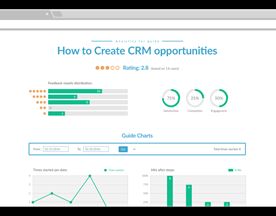Picture this: it’s your first day at a new job. You’re excited, a little anxious, but mostly eager to make your mark. You step into the office and find yourself lost in a maze of forms, introductions, and information overload. The first week turns into a blur of unorganized orientations, endless documents, and awkward silences during coffee breaks. Within the first month, you’re not so much integrated into your new role as you are merely surviving it. Sound familiar?
The experience I just described is what happens when employee onboarding goes awry, and sadly, it’s all too common. Onboarding, for those who might not be familiar, is the process by which new hires get adjusted to the social and performance aspects of their jobs quickly and smoothly. When executed poorly, it can lead to higher turnover rates, decreased productivity, and a negative company culture. Enter the game-changer: onboarding software.
In today’s post, we’ll delve deep into the world of onboarding software—why it’s essential, how it works, and how to choose the right one for your organization. We’ll also answer some frequently asked questions and give you a list of top onboarding hr software tools to consider.
Onboarding software enhances the new hire journey by automating tasks, tracking progress, and boosting engagement. It leads to heightened productivity, improved employee satisfaction, and better retention.

The Importance of Employee Onboarding
Onboarding is the bridge that carries a candidate from the excitement of receiving a job offer to becoming a confident and integrated employee. Underestimating the significance of this process is a common mistake, but its ramifications can be far-reaching. Here’s a deep dive into why new hire onboarding is so pivotal:
First Impressions are Everything
It’s a well-known fact that first impressions matter in our personal lives, and it’s no different in professional settings. New hires, in their early days, are incredibly receptive and observant. A positive onboarding experience helps set the tone for their entire tenure at a company. This period helps them gauge:
Company Culture: They discern the company’s values, work ethics, and dynamics.
Their Fit: They assess how they will fit in and contribute to the company’s broader goals.
Laying the Groundwork for Long-Term Retention
A well-structured onboarding process can set the stage for employee loyalty. When new hires feel that a company is investing time and resources in their success from day one, they’re more likely to reciprocate with commitment and dedication.
Boosting Productivity
Onboarding isn’t just about making new hires feel good; it’s also about getting them up to speed with their roles. With clear role expectations, adequate training, and the necessary resources at their fingertips, new hires can hit the ground running. In contrast, a disjointed onboarding can lead to longer ramp-up times, often causing frustration for both the employee and the manager.
Cultivating a Positive Company Culture
Every new hire added to the team either strengthens or weakens the company culture. A sound onboarding process ensures that new employees understand, appreciate, and align with the company’s values and norms. This alignment fosters a cohesive, collaborative, and harmonious work environment.
Reducing the Costs of Turnover
Finding and training a new employee is costly. Thus, every premature departure of an employee can hit the company’s finances and morale. Effective onboarding can mitigate these risks, ensuring that new hires find their footing quickly and are less likely to seek opportunities elsewhere.
Fostering Peer Relationships
Integrating socially can be as crucial as understanding one’s role in a new job. A comprehensive onboarding process often includes team-building activities and opportunities for new hires to forge connections with their colleagues. These relationships can be essential support systems as they navigate their new roles.
Key Takeaways:
First impressions set the stage for an employee’s perception of the company.
Effective onboarding can significantly enhance long-term retention and productivity.
A robust onboarding process reinforces positive company culture.
Reducing turnover and its associated costs is a tangible benefit of proper onboarding.
Fostering early peer relationships can provide invaluable support for new hires.

What is Onboarding Software?
Onboarding software is more than just a digital tool; it’s the virtual handshake that welcomes new hires into the fold of an organization. As businesses have evolved and the complexities of recruitment processes have grown, the need for a streamlined and efficient onboarding process has become undeniable. Onboarding software serves as a facilitator for this, ensuring that businesses can impart a positive initial experience to their employees. Here’s a deeper look into the intricacies of onboarding software:
The Genesis of Onboarding Software
In the early days, HR departments often relied on manual processes, which were both time-consuming and prone to errors. As companies expanded and recruitment volumes surged, the limitations of manual onboarding became painfully evident. It led to the genesis of onboarding software—digital platforms designed to simplify, automate, and optimize the entire employee onboarding experience.
A One-Stop Solution for HR and New Hires
Imagine having a singular platform that streamlines documentation, training modules, and assimilation processes. Onboarding software is precisely that—a comprehensive solution that benefits both HR personnel and new employees. For HR, it minimizes administrative burdens, while for new hires, it ensures a consistent, engaging, and informative introduction to their new roles and the company.
Core Features and Offerings
Automated onboarding workflow: This allows HR teams to set up task lists and schedules for each new hire, ensuring that they undergo every essential step in the onboarding process. From document submissions to introductory meetings, everything is streamlined.
Document Management: Gone are the days of physical paperwork. Onboarding software provides a centralized platform where all necessary documents—from employment contracts to tax forms—can be uploaded, filled, signed, and stored securely.
Training Modules: Training is integral to any onboarding process. Modern onboarding software often integrates e-learning platforms, allowing new hires to undergo training sessions, take quizzes, and even engage in interactive simulations relevant to their roles.
Analytics and Feedback: Monitoring the effectiveness of onboarding processes is vital for continuous improvement. Onboarding programs often comes with built-in analytics tools that provide insights on how new hires are progressing. Additionally, feedback modules allow new employees to share their experiences, helping HR teams refine and enhance the onboarding experience.
Social Integration: A unique feature of some advanced onboarding software is the integration of social elements. These may include platforms where new hires can interact, get to know their peers, and even participate in virtual team-building activities.
Customization is Key
Recognizing that no two companies are identical, many onboarding software solutions offer customizable platforms. This ensures that the software can be tailored to reflect the unique culture, values, and needs of each organization.
Key Takeaways:
Onboarding software has evolved as a response to the limitations of manual onboarding.
It provides a unified platform catering to both HR teams and new hires, streamlining the onboarding process.
With features ranging from automated workflows to social integration, onboarding software ensures a comprehensive onboarding experience.
The ability to customize these platforms allows businesses to mold the software in alignment with their unique needs and values.

Choosing the Right Onboarding Software
In today’s competitive landscape, where the struggle to retain top talent is real, the significance of a seamless onboarding process cannot be overstated. As a plethora of employee onboarding software solutions floods the market, making the right choice can be daunting. Here’s a comprehensive guide to ensuring you select the best onboarding software that truly resonates with your organization’s needs:
Understanding Your Organization’s Unique Needs
Every company, whether a startup or a global conglomerate, has its unique culture, processes, and requirements. Hence, before diving into the myriad of available options:
Assess Your Volume: If your company is hiring in large volumes, you’ll require software capable of handling bulk onboarding without hiccups.
Pinpoint Specific Requirements: Do you need a software mainly for document management? Or is interactive training your primary focus? Listing down your priorities can significantly narrow down options.
Ease of Use and User Experience (UX)
An intuitive interface is crucial. If the software is cumbersome or non-intuitive, HR teams and new hires will struggle, negating the very purpose of a streamlined process. Consider:
Demo Runs: Many providers offer demo versions. Take advantage of this to gauge the software’s user-friendliness.
Feedback: Look into reviews from other businesses that have employed the software. Their experiences can offer invaluable insights.
Integration Capabilities
In today’s interconnected digital age, it’s unlikely that onboarding software will function in isolation. It needs to communicate seamlessly with other HR systems, payroll solutions, or training modules. Ensure that the software:
Supports API Integrations: This ensures it can connect effectively with other tools your organization utilizes.
Offers a Suite of Tools: Some advanced solutions provide an all-in-one suite, integrating recruitment, payroll, and performance management within the onboarding tool.
Scalability
Your organization won’t remain static. As it grows and evolves, the onboarding software should be able to scale accordingly. Check:
User Limitations: Ensure there are no restrictions on the number of users or onboardees.
Modular Additions: Some tools allow you to add modules or features as your needs expand.
Security and Compliance
With sensitive personal data being input and stored, the software’s security framework is paramount. Additionally, it should help you stay compliant with labor laws and regulations. Scrutinize:
Data Encryption: Ensure that data storage and transfers are encrypted.
Regular Updates: The software provider should offer regular updates to stay abreast of any compliance changes.
Customer Support and After-Sales Service
Even the most tech-savvy teams can encounter issues. When they do, a responsive support team can make all the difference. Prioritize:
24/7 Support: Issues don’t always arise during business hours. Round-the-clock support can be a lifesaver.
Training and Onboarding for the Software: Ironically, while you’re onboarding employees, your team might need onboarding for the software. Many providers offer training sessions to ensure you’re making the most of the tool.
Key Takeaways:
Understand your organization’s specific needs before diving into software options.
Prioritize user experience and ease of use.
Integration and scalability are vital for future-proofing your choice.
Security and compliance are non-negotiable.
Strong customer support can significantly enhance your experience with the software.

Top 5 Onboarding Software Tools
In today’s digital era, an array of onboarding software tools has emerged, each promising a unique set of features designed to make the onboarding process a breeze. But with so many options on the table, it can be overwhelming to decide which one is the best fit for your organization. To help you make an informed choice, let’s dive deeper into the top 5 onboarding software tools that have garnered significant attention for their innovative offerings:
BambooHR
Overview: BambooHR is often lauded for its user-friendly interface and comprehensive suite of HR tools, making it a favorite among both startups and established corporations.
Key Features:
Employee Self-service: Allows new hires to fill out paperwork, set up profiles, and access training modules at their own pace.
Customizable Workflows: You can tailor the onboarding process based on job role, department, or location.
Integrated Compensation: With built-in payroll functionalities, BambooHR ensures a smooth transition from recruitment to the first paycheck.
Why Choose BambooHR?:
If you’re looking for a comprehensive HR solution that goes beyond just onboarding.
You prioritize a seamless, intuitive user experience.
WorkBright
Overview: Designed for remote task management, WorkBright offers a unique touch to the onboarding process, focusing on businesses with a remote or non-desk workforce.
Key Features:
Remote Task Management: Perfect for businesses that rely heavily on remote workers or have multiple locations.
Document Management: Allows for easy submission and approval of essential paperwork, even from a mobile device.
Automatic Reminders: Sends out reminders for incomplete onboarding tasks or missing documents.
Why Choose WorkBright?:
If your organization heavily depends on remote or dispersed teams.
You want a tool that can easily handle documentation with mobile accessibility.
SAP SuccessFactors
Overview: As a part of the SAP suite, SuccessFactors combines robust enterprise capabilities with user-centric features, catering to large corporations with complex onboarding needs.
Key Features:
Cross-boarding Capabilities: Not just for new hires, it facilitates transitions for internal movements too.
Goal Setting: Integrates performance metrics and goal-setting within the onboarding process.
Learning Hub: Offers a plethora of learning resources for new hires.
Why Choose SAP SuccessFactors?:
If you’re a large enterprise with intricate HR and onboarding requirements.
You’re already invested in or familiar with the SAP ecosystem.
Gusto
Overview: Gusto simplifies the HR, payroll, and benefits process, making it especially appealing for small to medium-sized businesses.
Key Features:
Automated Compliance Updates: Keeps you updated on state-specific compliance regulations.
Integrated Benefits: Seamlessly integrates health benefits and other perks into the onboarding process.
Time Tracking: Incorporates time tracking for better work management.
Why Choose Gusto?:
If you’re a small or medium enterprise wanting an all-in-one HR solution.
You value having a tool that automatically updates compliance changes.
Talentsoft
Overview: Talentsoft’s strength lies in its adaptability. Designed to cater to both local and global organizations, it molds itself to various HR landscapes.
Key Features:
Localized Onboarding: Tailors the onboarding experience based on geographic and cultural nuances.
Continuous Feedback Loop: Encourages regular feedback, facilitating continuous improvement.
Integrated Learning and Development: Focuses on holistic employee growth right from day one.
Why Choose Talentsoft?:
If you’re a global organization with diverse teams spread across various geographies.
You’re looking to intertwine learning and development seamlessly into your onboarding process.
Key Takeaways:
Each software tool comes with a unique set of features tailored for different organizational needs.
Whether it’s comprehensive HR management, remote task handling, enterprise-level robustness, simplicity, or adaptability, there’s a solution for every requirement.
Evaluating your specific needs and matching them with the strengths of these software tools can lead you to the perfect fit for your organization.

FAQ
What is Employee Onboarding?
Employee onboarding is the process that helps new hires integrate into a company efficiently and smoothly.
Why is Onboarding Important?
Effective onboarding sets the tone for an employee’s journey, helps in retention, and ensures productivity.
What Does Onboarding Software Do?
It automates various aspects of the onboarding process, making it more organized and efficient.
Is Onboarding Software Expensive?
The cost varies depending on the features, scalability, and customizability of the software.
How Does Onboarding Software Affect Employee Retention?
Effective onboarding facilitated by software can significantly improve employee retention.
What Should I Look for When Choosing an Onboarding Software?
Consider compatibility, scalability, and user experience.
Is It Possible to Customize Onboarding Software?
Most onboarding software allows customization to some extent.
How Secure is Onboarding Software?
Security measures vary, so it’s crucial to check what security features are included.
Can I Use Onboarding Software for Remote Employees?
Yes, many onboarding software options offer features suitable for remote onboarding.
Do I Need Technical Skills to Use Onboarding Software?
No, most onboarding software is designed to be user-friendly and intuitive.

Conclusion
In our ever-evolving digital era, the importance of a smooth, engaging, and efficient onboarding process has never been more pivotal. A good first impression isn’t just for show; it’s the foundation of a long-lasting, productive relationship between the employee and the organization. The first days set the tone, and with an effective onboarding process powered by the right software, you’re setting up both your new hires and your business for success.
Remember, employees are the heart of an organization. They bring with them a unique set of skills, perspectives, and experiences that can drive your business forward. But, to truly unlock this potential, it’s vital to provide them with the resources, training, and support they need right from day one. This doesn’t just mean giving them a computer and a desk; it’s about integrating them into the company culture, making them feel valued, and setting clear expectations.
And while the perfect onboarding experience might differ from one company to the next, the underlying principle remains consistent: to create a seamless transition from being an applicant to becoming a thriving member of the team. With the help of onboarding software, this transition becomes all the more manageable. It provides structure, ensures consistency, and most importantly, it allows HR teams to focus on the human aspect of onboarding, building connections, and fostering relationships.
But as we’ve delved into today, not all onboarding software is created equal. Each offers a unique blend of features tailored to various needs. Whether you’re a budding startup or a multinational conglomerate, the key lies in identifying what you want to achieve with your onboarding process and aligning that with the capabilities of the software.
In conclusion, while the tools and technologies we employ in the onboarding process are critical, let’s never forget the ultimate goal: to welcome, engage, and empower our newest team members, ensuring they’re set on a path to success from day one.
Key Takeaways:
The onboarding process is the foundation of a productive relationship between new hires and the organization.
Onboarding software aids in ensuring a consistent and streamlined experience for every new employee.
The right tool depends on an organization’s specific needs and objectives.
Ultimately, the objective is to integrate, engage, and empower new team members effectively.












